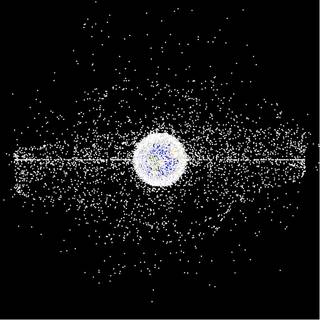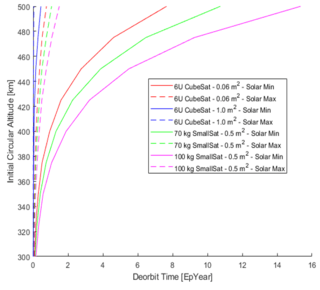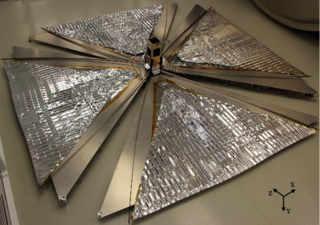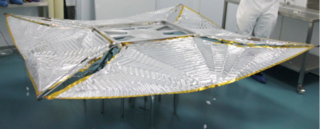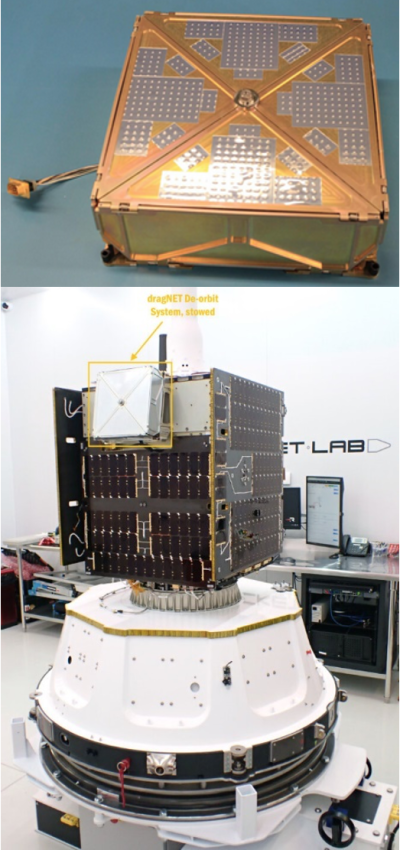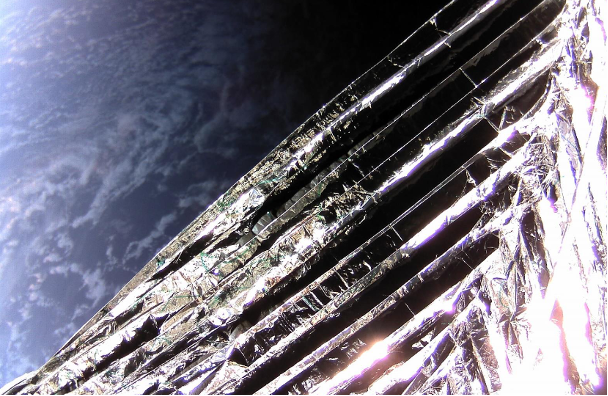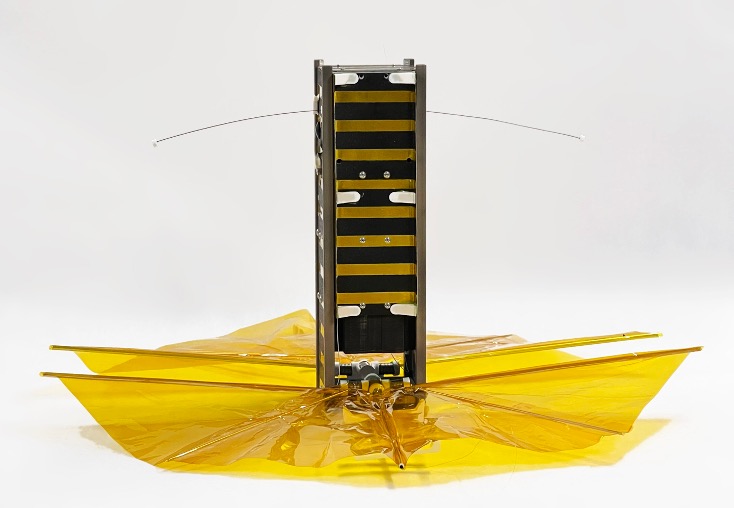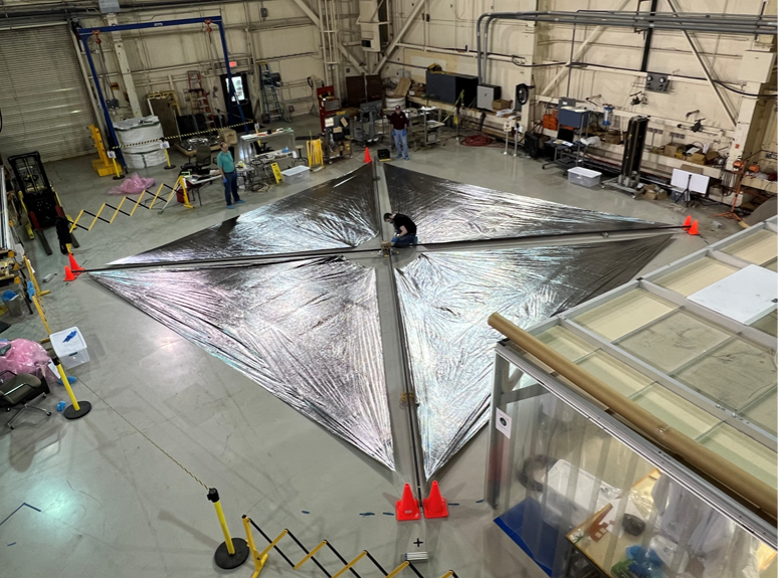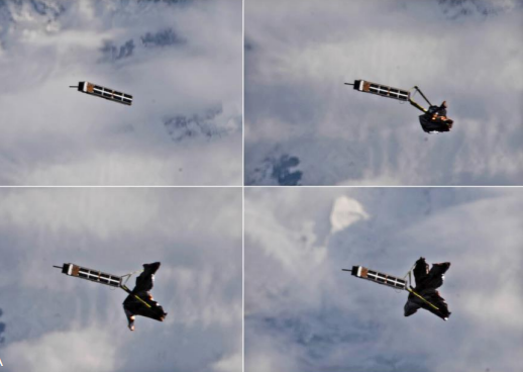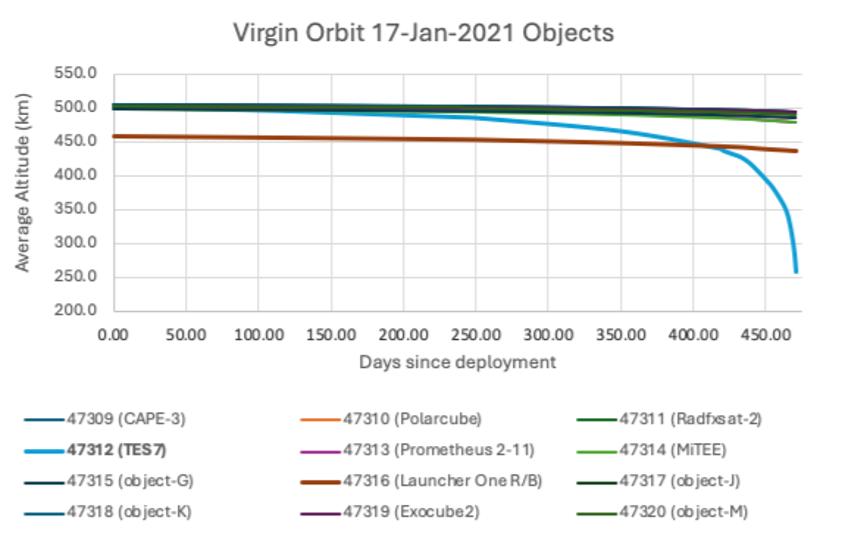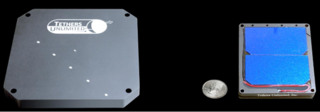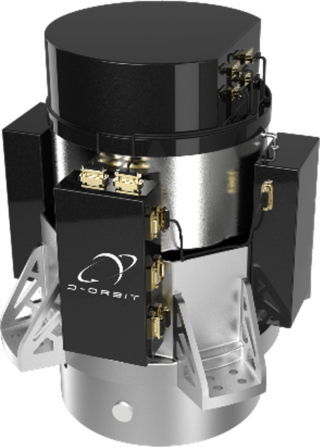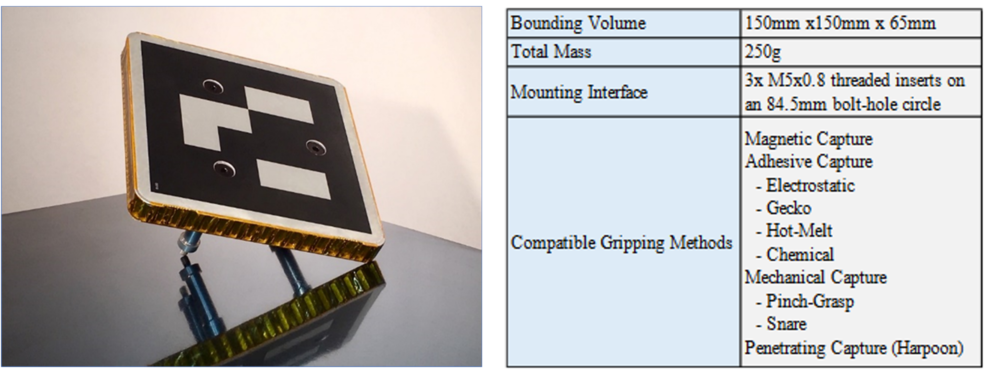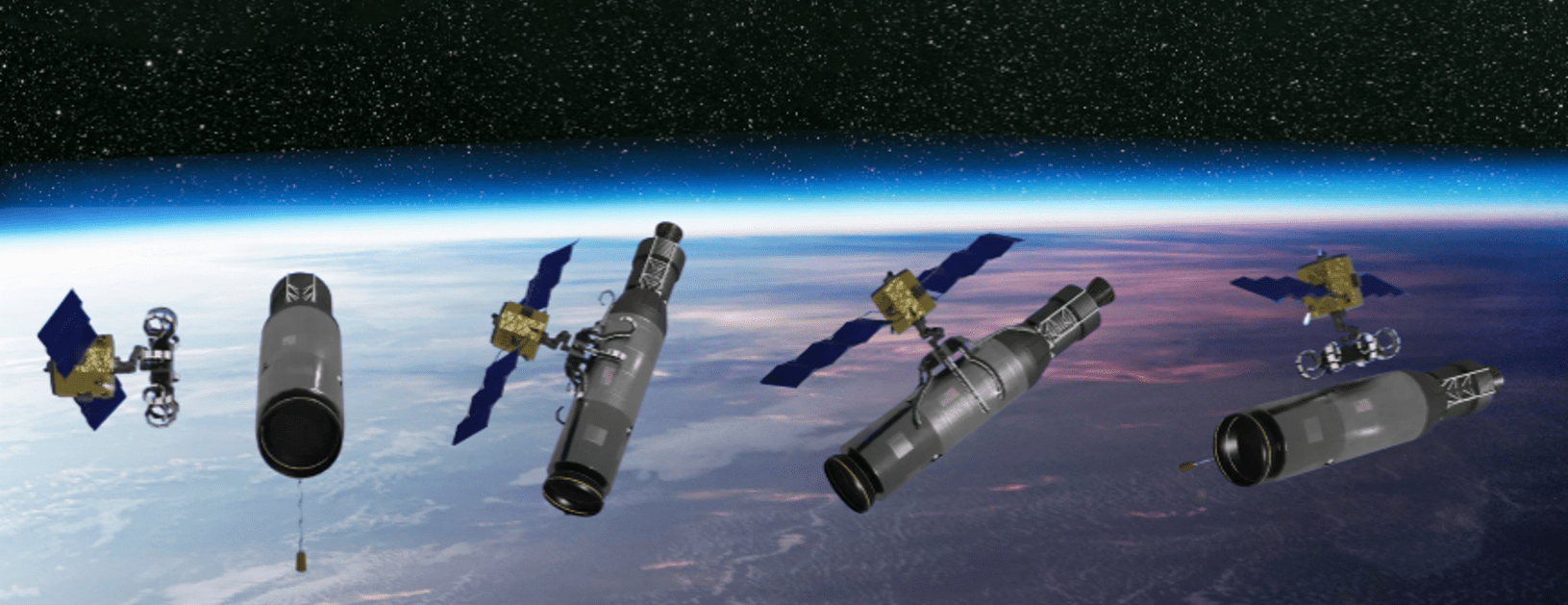Chapter Contents
- Chapter Glossary
- 13.1 Introduction
- 13.2 Orbital Debris Regulations
- 13.3 State-of-the-Art – Passive Systems
- 13.4 State-of-the-Art – Active Deorbit Systems
- 13.5 Summary
- References
Chapter Glossary
| (ADCS) | Attitude Determination and Control System |
| (AEOLDOS) | Aerodynamic End-of-Life Deorbit system for CubeSats |
| (AFRL) | Air Force Research Laboratory |
| (ARC) | Ames Research Center |
| (CRD2) | Commercial Removal of Debris Demonstration |
| (D3) | Drag Deorbit Device |
| (DOM) | De-orbit Mechanism |
| (EOL) | End-Of-Life |
| (ESEO) | European Student Earth Orbiter |
| (FURL) | Flexible Unfurlable and Refurlable Lightweight |
| (GCD) | Game Changing Development |
| (GTO) | Geosynchronous Transfer Orbit |
| (HSC) | High Strain Composite |
| (IADC) | Inter-Agency Space Debris Coordination Committee |
| (ISS) | International Space Station |
| (JAXA) | Japan Exploration Space Agency |
| (MSFC) | Marshall Space Flight Center |
| (RODEO) | Roll-Out DeOrbiting Device |
| (SBIR) | Small Business Innovation Research |
| (SSO) | Sun-synchronous orbit |
| (STMD) | Space Technology Mission Directorate |
| (TRL) | Technology Readiness Levels |
| (TTP) | Thermosphere Test Probe |
| (UTIAS-SFL) | University of Toronto Institute for Aerospace Studies Space Flight Laboratory |
| (VESPA) | Vega Secondary Payload Adapter |
13.1 Introduction
Space debris, also known as orbital debris or space pollution, are derelict artificial objects left in space on purpose or accidentally that include larger nonfunctional spacecraft and rocket bodies, and smaller disintegrated mission-related objects such as lens caps, ejected bolts, or even paint flakes. Additionally, larger space debris are commonly broken up into even smaller fragments due to collisions, erosion, or expelled particles from the spacecraft or rocket bodies. This presents a major problem in the space environment as spacecraft can be damaged or destroyed by space debris collisions due to the very high velocities of the debris objects, which then produces even more space debris.
While space debris is present throughout space, there is a large accumulation around Earth particularly in low-Earth orbit (LEO) where most space operations take place. This is also attributed to the increased launch cadence of small spacecraft and the recent surge in constellations in the past decade. Improved access to space has made LEO accessible and less expensive for more countries, organizations, and institutions to launch small spacecraft, which adds to the associated risks and threats of space debris. Estimates of the accumulation of orbital debris suggest approximately 1,100,000 objects with a diameter 1 – 10 cm, and over 36,500 pieces with diameters >10 cm, are in orbit between geostationary, equatorial, and LEO altitudes (1). Figure 13.1 shows a representation of the orbital debris around Earth. Additionally, the orbital lifetime of space debris can be extremely long since atmospheric drag is only effective at <250 km (2).
Due to the inherent problem of space debris, there are ongoing policy measures to establish the importance of mitigating and removing space debris. The general guideline is that spacecraft in LEO must deorbit, also known as decay, or be placed in graveyard orbit within a maximum of 25 years after the completion of their mission (3).This standard spacecraft lifetime regulation has been recently updated that directs NASA and other national agencies to reassess current mitigation policies, especially regarding the potential advantages and cost implications resulting from limits on the space debris orbit lifetime (4). These regulations have incorporated spacecraft decay capabilities into mission design.
The rate of spacecraft decay in LEO depends on several factors, including the initial orbit insertion, the ballistic coefficient of the spacecraft, and solar weather conditions, which all play a fundamental role in the ability to comply with decommissioning regulations. Small spacecraft designers have examined various strategies for complying with decommissioning regulations to accelerate spacecraft decay post mission: spacecraft are launched in a lower orbit for a natural decay within a few years or equipped with deorbit systems to encourage altitude decay and ultimately reenter and burn up in the Earth’s atmosphere. Natural decay in <5 years can be achieved for most smallsats at altitudes <400 km, however several smallsat missions must be in orbits beyond 400 km making them susceptible to use deorbit methods.
Spacecraft deorbit methods are either passive or active. Passive deorbit methods have gained maturity since the last iteration of this report, and there are more devices with high Technology Readiness Levels (TRL≥8) that are guaranteed to satisfy current lifetime requirements. Traditionally, passive systems were the main option for deorbiting due to their increased simplicity, however recently active methods are gaining traction. Common active deorbiting requires attitude control and, in some cases, surplus propellant post-mission, such as a steered drag sail that relies on a functioning attitude control system, or on actuators for pointing the sail. Propulsion devices for deorbiting techniques are considered risky due to potential failure or malfunction of either the spacecraft, up until its final stage of decommission, or the propulsive technology itself. Adequate attitude control and navigation capabilities after the mission for a controlled reentry are never a guarantee. Some of the new active deorbiting solutions include a separate spacecraft that can attach to the defunct satellite to bring it down to lower orbits where the satellites can complete the deorbit using their own drag decay.
The influx of small spacecraft in LEO has also developed space situational awareness and space traffic management data. For more information, please see the Identification and Tracking Systems chapter.
Chapter Organization
This chapter is organized as follows:
- Orbital Debris Regulations (13.2)
- State-of-the-Art – Passive Deorbit Systems (13.3)
- State-of-the-Art – Active Deorbit Systems (13.4)
Orbital space debris has been a known issue, and there has been ongoing research in this field. It is now a hot topic item and the Orbital Debris Regulations section provides a comprehensive understanding of the current policy regulations for deorbit mitigations, when they were initiated, and the organizations that implement space orbiting debris regulations. The Passive and Active Deorbit System sections contain technology description, summary table of devices; and previous, current and planned missions. This chapter provides a comprehensive guide to existing commercial technologies and technology demonstrations for both methods, and the authors have attempted to highlight technology gaps within existing deorbiting capabilities and current development status on each deorbit method.
The information described below is not intended to be exhaustive but provides an overview of current state-of-the-art technologies and their development status as discussed in open literature. Companies mentioned in this chapter are presented as informational only and do not represent an endorsement by NASA. There is no intention of mentioning certain companies and omitting others based on their technologies or relationship with NASA. It should be noted that TRL designations may vary with changes specific to payload, mission requirements, reliability considerations, and/or the environment in which performance was demonstrated. Readers are highly encouraged to reach out to companies for further information regarding the performance and TRL of described technology.
Definitions
- Disposal refers to removal of spacecraft from orbital environment.
- Deorbit refers to lowering spacecraft’s orbital altitude, also referred to as Decay.
- Decay refers to a gradual decrease of the distance between a spacecraft and the Earth.
- Atmospheric Drag refers to molecular collisions with the spacecraft body.
- Drag Area refers to the spacecraft surface area experiencing atmospheric resistance.
- Orbital Lifetime refers to total time spacecraft is in orbit.
13.2 Orbital Debris Regulations
Space debris has been a concern for several decades, but with visible sightings of reentry fragments of spacecraft and rocket bodies, the urgency to address space debris has grown. NASA’s Orbital Debris Program Office[1] was created in 1979, the Air Force Space Debris Research Program was initiated in the 1980s. NASA was among the first organizations to implement plans for mitigation and remediation of space debris in the early 1990s, and in 1993 the Inter-Agency Space Debris Coordination Committee (IADC) was founded internationally.
NASA collaborated with the Department of Defense in 1997 to develop the U.S. Government Orbital Debris Mitigation Standard Practices (ODMSP) (5). The agency’s most updated orbital debris guidelines can be found in NASA NPR 8715.6B “NASA Procedural Requirements for Limiting Orbital Debris and Evaluating the Meteoroid and Orbital Debris Environments” (6) and NASA Standard 8719.14C “Process for Limiting Orbital Debris” (3). These technical documents describe the processes and requirements to limit orbital debris for all NASA spacecraft missions. The guidelines, among other considerations, include a limit on the risk of potential human casualties caused by reentering debris, which shall not be greater than 1 in 10000 (5). Of the three spacecraft disposal methods identified – direct retrieval, atmospheric re-entry, and maneuvering into a storage orbit – atmospheric reentry was deemed as the most feasible for the majority of spacecraft missions. Therefore, a maximum 25-year post-mission orbital lifetime (no longer than 30 years after launch or a move into a graveyard orbit for safe storage) was established for all US spacecraft. The rationale for this specific orbital lifetime was based on the least amount of propellant required to maneuver to a lower orbit as predicted by various orbital debris models (7).
The IADC is an entity formed by national and multi-national space agencies, including NASA, ESA, JAXA and several others, and is widely recognized by the international community as the technical authority on space debris. In 2002, the IADC established the Space Debris Mitigation Guidelines to address orbital debris. Their findings and procedures are submitted to the United Nations (UN), as space debris has been one of the main interests of the UN Committee on the Peaceful Uses of Outer Space (COPUOS). In 2007, space debris mitigations guidelines based on the IADC procedures were accepted by the COPUOS and endorsed by the UN (5). The IADC adopted the 25-year orbital lifetime guideline for space objects in LEO.
The U.S. Federal Communications Commission (FCC) regulates all radio communication across the U.S. and all U.S. spacecraft must be licensed for space communications. Since the early 2000s, the FCC has deliberated over how best to mitigate orbital debris from FCC-authorized space activities, and formally adopted debris mitigation regulations (2) in 2004. These FCC regulations include orbital debris mitigation plans as part of license applications, and require applicants to disclose “the design and operational strategies that they will use, if any, to mitigate orbital debris,” and to “identify particular methods by which a proposed satellite system will mitigate orbital debris” (2). The FCC adopted the ODMSP 25-year lifetime guideline as well, and commented that the 25-year “rule” should be tightened, as this no longer adequately addresses current orbital debris issues arising from the launch of large constellations and the expected increase in future LEO space activity. On September 29th, 2022, the FCC adopted a new rule for all FCC-licensed satellites within the LEO region (<2000 km) to reduce the lifetime requirement to 5 years after launch (8). There are ongoing discussions at the agency and federal level to determine the final policies.
Since this updated “5-year lifetime rule” by the FCC, there has been increased focus on space debris removal activities. In April 2023, the FCC created a new Space Bureau responsible for the regulation of satellites and space debris (9). The World Economic Forum (WEF) released the ‘Space Industry Debris Mitigation Recommendations’ document in June 2023 to standardize a series of recommended behaviors for satellite operations. One of these listed recommendations is to target five years or less after end-of-life for spacecraft removal. The document was signed by several companies including Airbus, The Aerospace Corporation, SES, and Planet. The WEF collaborated with ESA, the MIT Media Lab, and other stakeholders to establish a Space Sustainability Rating (SSR) system to provide a measurable score that can characterize spacecraft mission compliance with the international space debris remediation guidelines (10)(11).
The Federal Aviation Administration (FAA) announced on September 20th, 2023, a proposal to create a new rule to limit the growth of debris from commercial launch vehicles in order to reduce collision risk and limit space debris in populated LEO environments (12). The new regulation will give commercial launch operators specific options for orbital debris countermeasures, requiring disposal of their rocket upper stages by performing a controlled reentry within 30 days after mission completion, moving to a less congested or graveyard orbit (within 30 days), placing them in an Earth escape trajectory (within 30 days), retrieving them with active debris removal within five years after launch, or performing an uncontrolled atmospheric disposal within 25 years.
1https://www.orbitaldebris.jsc.nasa.gov/
13.2.1 Considerations for Orbital Lifetime Requirements in LEO
Small spacecraft launched at or around the 400 km altitude naturally decay in under five years, however at orbital altitudes beyond 500 km, there is no guarantee the spacecraft will deorbit within that timeframe and some may have trouble deorbiting in under 25 years. This is due to potential low atmospheric density conditions and the effects on various ballistic coefficients, as seen in Figure 13.2. This graph displays various cases of SmallSats with distinct masses, drag areas, and initial orbits, under the atmospheric density conditions during the 11-year solar cycle maximum and minimum.
The varying solar weather conditions can affect the deorbit performance for a given altitude and can have a significant impact on orbital lifetimes. The atmospheric drag force that satellites experience is increased during solar maximum, resulting in a faster decay. In this situation, the Sun emits extra energy in the atmosphere and creates higher density layers in LEO altitudes that produce a stronger drag force on the satellites (13). It is common for some missions to plan their launch periods around the solar cycle, and if the stricter 5-year orbital lifetime requirement becomes widely accepted, more companies may want to consider this, as the deorbit time can be reduced by more than 10 years as seen in Figure 13.2.
Another important factor that affects orbit propagation in LEO is the spacecraft’s Ballistic Coefficient (BC). The BC is defined in this chapter as the mass to area ratio multiplied by the inverse of the drag coefficient, that is assumed to equal 2.2. By this definition, a spacecraft with a lower ballistic coefficient will decay faster due to the smaller mass to area ratio. As shown in Figure 13.2, a 6U spacecraft with an area of 0.06 m2 and an assumed mass of 6 kg has a ballistic coefficient of 45, which is significantly lower than a 100 kg spacecraft of 0.5 m2 with BC of 90.
Since timing the launch for a particular solar weather scenario may not be feasible, another strategy for satellite operators to comply with orbital lifetime requirements is to decrease their spacecraft ballistic coefficient or mass to area ratio. Deorbit technologies such as drag devices can effectively increase the spacecraft’s drag area and may become even more important for spacecraft operations in LEO.
13.3 State-of-the-Art – Passive Deorbit Systems
Passive deorbit methods require no further active control after deployment, relying only on natural perturbations and forces to deorbit. They are popular for their minimal mass, power, and cost constraints, and high reliability. Passive methods consist of a deployed structure, such as drag sail, boom, and electromagnetic tether, to reduce the spacecraft’s ballistic coefficient. This raises the atmospheric drag on the spacecraft which accelerates the reentry process. These techniques have greatly matured in the last ten years, and recent developments have made passive deorbit technology well-known and space ready.
This section provides information on drag sails, deployable booms, and electromagnetic tethers. In the last decade, there have been several SmallSat missions that have demonstrated passive deorbit capabilities with a deployed sail, boom, or tether. Some notable deorbit missions led by academic programs, research and government organizations, and commercial entities are described under Missions for each deployed structure.
13.3.1 High TRL Drag Sails
Drag devices are the most common deorbit device for satellites orbiting in LEO. They are advantageous due to simplicity and small stowed volumes. For certain area-to-mass ratios in altitudes equal to or lower than 800 km, drag devices can be deployed to increase the drag area for faster deorbiting in compliance with the new 5-year requirement. This technology has been implemented in several small spacecraft missions, and several companies and institutions are developing prototypes that are increasingly more mature, providing solutions to the space debris problem for missions that do not have resources for an active system.
Many mission designers are discovering that drag sails do not need to be complicated in material or shape to be effective. It is important to note some missions described below have more information since they are publicly available. Found at the end of this section, Table 13-1 summarizes state-of-the-art passive deorbit systems. Solar sail technology development and mission information are found in the In-Space Propulsion chapter.
Missions
In January 2011, the NanoSail-D2 mission successfully demonstrated a drag sail to deorbit the spacecraft from a 650 km altitude and 72° inclined orbit. NanoSail-D2 was deployed from the minisatellite FASTSat–HSV to demonstrate the deorbit capability of a low mass, high surface area sail. The 3U spacecraft, developed at NASA Marshall Space Flight Center (MSFC) and Ames Research Center (ARC), reentered Earth’s atmosphere in September 2011.
CanX-7 started at an initial ~700 km Sun-synchronous orbit (SSO), deployed a drag sail in May 2017 and re-entered April 2022. The sail was developed and tested at University of Toronto Institute for Aerospace Studies Space Flight Laboratory (UTIAS-SFL) (Figure 13.3). The CanX-7 deorbit technology consists of a thin film sail that is divided into four individual modules that each provide 1 m2 of drag area. These sail sections are deployed mechanically with spring booms, which help to preserve the geometry. Each module also has electronics for individual telemetry and command that allowed different sections to be controlled separately to mitigate risk of a single failure, and for custom adaptability to various spacecraft geometries and ballistic coefficient requirements for other missions (22).
The Surrey Space Centre based in the United Kingdom developed DragSail technology that was implemented in a family of missions. Funded by the European Commission QB50 program and the DEPLOYTECH partnership that included German Aerospace Centre (DLR) and NASA Marshall Space Flight Center, among others, the Inflatesail 3U CubeSat first demonstrated the DragSail in 2017 and included a mast/drag-sail technology that successfully deorbited the satellite in just 72 days. This achievement was the first time a spacecraft has deorbited using European inflatable and drag-sail methods (18).
The RemoveDebris mission, developed under the European Commission FP7 program by a consortium of several institutions such as Airbus and the Surrey Space Centre consisted of a 100 kg small spacecraft deployed from the ISS in 2018. One of the experiments it carried was a passive drag augmentation device consisting of a sail. The sail was deployed in March 2019, however, trajectory data showed it only partially deployed since no significant altitude change was measured. The lessons learned from this incident were implemented in another version for the Space Flight Industries’ SSO-A mission that incorporated two of these sails. In that case, the assembly did not include an inflatable boom (21).
As part of the ESA CleanSat program, Cranfield Aerospace Solutions developed a variety of drag augmentation systems called Icarus which are similar to other drag devices where drag is increased by deploying a membrane sustained by rigid booms. The first demonstrated was the Icarus-1 sail that flew on the TechDemoSat-1 mission from SSTL launched in 2014 and re-entered May 2019. Another version also flew on the Carbonite-1 spacecraft also built by SSTL that launched in 2015. The Icarus sail is a thin aluminum structure located around the satellite side panel that contains four stowed Kapton trapezoidal sails and booms. The Icarus-1 sail system had a mass of 3.5 kg for about 5 m2 of sail area, and the Icarus-3 sail had a mass of 2.3 kg for 2 m2 sail area (Figure 13.4). Another technology developed by Cranfield Aerospace Solutions is a de-orbit mechanism (DOM) device similar to the Icarus drag sail but in a smaller cuboid outline. The mechanical system varies from Icarus since the sails are triangular and the booms work as tape springs themselves. This system flew on the European Student Earth Orbiter (ESEO) that was a 45 kg satellite with several student payloads launched in March 2018. The DOM module has a mass of 0.5 kg and will deploy a sail with an area of 0.5 m2 to deorbit ESEO after decommissioning (16).
MMA Design LLC patented the dragNET de-orbit system, which is a 2.8 kg module (Figure 13.5) featuring four stowed thin membranes that deploy through a single heater-powered actuator. The sail has an area of 14 m2 that can effectively deorbit a 180 kg spacecraft at an altitude of 850 km in less than 10 years. The dragNET was a part of the ORS-3 Minotaur Upper Stage and facilitated its deorbit in 2.1 years after launch in November 2013. In October 2022, the dragNET deorbit system was launched as part of the General Atomics GAzelle satellite, as seen in Figure 13.5, and is still operational (15).
Purdue University, CalPoly and Georgia Tech jointly developed a drag device with a pyramid geometry that aims to deorbit a satellite from a geosynchronous transfer orbit (GTO). The Aerodynamic Deorbit Experiment (ADE) is a 1U CubeSat technology demonstration that once deployed, will occupy an area of about 1 m2 to decrease the spacecraft’s ballistic coefficient to the perigee altitude in each pass, resulting in an expected lifetime of 50 – 250 days instead of the initially estimated seven years (42). The ADE mission is slated to launch in 2025.
The ADE technology was licensed to Vestigo Aerospace which is commercializing it with their Spinnaker series of drag sails and was awarded by NASA’s Phase II Small Business Innovation Research (SBIR) Program. An initial flight test of an 18 m2 sail was attempted in September 2021 aboard the first Firefly Aerospace Alpha rocket, however the launch was unsuccessful (45). Vestigo is developing two main products: a sail targeted for small satellites that has a surface area of 1.77 m2, and a larger 18 m2 sail for objects weighing up to 1000 kg (46). In 2023, Vestigo was awarded a NASA Phase II-S SBIR contract to contribute to the development of a technology demonstration mission to qualify the Spinnaker 2, an 8 m2 sail for small satellites, and the Spinnaker 3, more targeted to orbital transfer vehicles and upper stages (47).
NPC Spacemind developed and launched a series of CubeSat missions that demonstrated their ARTICA deorbit system, which consists of a deployable 2.1 m2 drag sail. The total size of the deorbiting system is 0.3 U which makes it suitable for CubeSats as small as 1U (28). In November 2022 and in January 2023, the DanteSat 3U CubeSat, and the Future-SM3 6U CubeSat, Futura-SM3, were respectively launched and successfully operated with an ARTICA system onboard. These two new missions extend the ARTICA flight heritage after the earlier UrsaMaior, 1-Kuns, and Alpha missions, launched in 2017, 2018 and 2020 respectively (28).
The Planetary Society’s LightSail-2 was a 3U CubeSat mission with a solar sail launched in June 2019 and deployed from the Prox-1 satellite once in orbit. The mission demonstrated that solar sail technology can be used in LEO by modifying its orbit altitude along the course of the mission. The 32 m2 sail was able to extend the mission lifetime by reducing orbital decay and on some occasions, it was also able to overcome drag entirely. In late November 2022, the mission successfully re-entered the atmosphere according to orbital predictions (30).
The Drag Augmentation Deorbiting System (ADEO) is a scalable drag sail developed by High Performance Space Structure Systems (HPS). There are various configurations of the ADEO sail: the ADEO-N series is tailored for small satellite missions of 20-250 kg, while the ADEO-M and ADEO-L target larger sizes, 100-700 kg and 500-1500 kg respectively. The ADEO-N series corresponds to sail sizes of 5±2 m2, while ADEO-M covers areas within 15 ± 5 m2. There are other smaller versions as well for picosatellites (ADEO-P) and CubeSats (ADEO-C) in particular, and the option to configure the sail size according to customer needs. Various configurations of the ADEO-N product family have been tested already. The NABEO-1, launched in 2018, attached to the center of a Rocket Lab Electron rocket Kick Stage and the sail was deployed 90 minutes after launch (24). In late December 2022, the ADEO-2 sail was deployed with a 10x10x10 cm package from the D-orbit ION-2 satellite carrier (Figure 13.6).
Gama launched its first spacecraft mission, a 6U CubeSat name Gama Alpha, in January 2023 into a ~550 km LEO and is currently still in orbit. This first technology demonstration mission aims to test the deployment and control of their 73.3 m2 solar sail, and the final phase of the mission will use the sail to rapidly deorbit the satellite (32).
SBUDNIC, a CubeSat designed and built by Brown University students with support from D-Orbit shown in Figure 13.7, AMSAT-Italy, La Sapienza-University of Rome, and NASA Rhode Island Space Grant, demonstrated a practical, low-cost method to cut down on space debris. Rather than taking debris out of orbit after it becomes a problem, this $30 drag device made from Kapton polyimide can be added onto satellites to radically reduce how long they’re in space. SBIDNIC was launched on a SpaceX rocket May 2022 as part of the Transporter 5 ridesharing mission. The plastic drag sail was deployed at about 520 kilometers and the satellite re-entered August 2023, about five years ahead of schedule (50).
The Advanced Composite Solar Sail System (ACS3) is a mission developed at NASA Langley and NASA Ames that consists of a spacecraft that will deploy an 81 m2 solar sail in a 1000 km sun-synchronous orbit (see Figure 13.8). The main objective of the mission is to demonstrate that solar radiation pressure can propel the spacecraft to change the semimajor-axis and obtain a different orbit altitude. The sail is composed of a combination of composite materials with distinct properties, and it will be deployed with lightweight booms from a 12U CubeSat bus, developed by NanoAvionics. The spacecraft was launched aboard an Electron launch vehicle in April 2024. Although the main objective of the mission is to show the propulsive capabilities of the solar sail, the device can be used for deorbiting purposes, and it may be used at the end of the ACS3 spacecraft lifetime for decommissioning (31).
TechEdSat (Passive) Exo-Brake Series
The Technology Educational Satellite program, also known as TechEdSat-n (TES-n), at NASA Ames Research Center (ARC) has contributed significantly to the development of drag devices. It consists of a series of nanosatellite technology demonstrations in collaboration with several universities including San Jose State University and the University of Idaho. One of the main goals of the program is to test and improve deorbiting techniques and develop a unique targeting capability with their own drag device design known as the Exo-Brake. Being used as both a passive and a controlled active deorbit system, the Exo-Brake is an atmospheric braking system that is distinguished from other drag devices with its parachute qualities instead of a solar sail due to its primary tension-based elements – see Figure 13.9. This is fundamental for accurate deorbit targeting since the device must retain its shape without collapsing during those critical reentry moments occurring at the atmosphere interface altitude of 100 km, known as the Von Karman line (35). Development of the Exo-Brake is funded by the Entry Systems Modeling project within the NASA Space Technology Mission Directorate’s (STMD) Game Changing Development (GCD) program.
The Exo-Brake was first implemented as a passive deorbit device on TES-3 and TES-4, and then on TES-5 and TES-7. In comparison to other objects without a disposal device, the TES-7 flight is shown with other deployed objects from the same carrier, as seen in Figure 13.10. With a low ballistic coefficient induced by the deployed Exo-Brake, it is seen that the TES-7 re-enters in roughly 1.3 years from an initial 500 km orbit. This design incorporated a compact, low volume gas generator cartridge that inflated the Exo-Brake struts.
More recently, a simpler mechanical deployment scheme was developed (patent initiated) that improves the packaging performance in terms of increasing the ratio of a key performance parameter (deployed-drag area per stowage volume) applied to TES-11. This has been further miniaturized for TES-22 which is expected to launch in December 2024 as a test for a proposed future Thermosphere Test Probe (TTP) that could be part of a small cohort during solar coronal events. The passive Exo-brake (not drag-modulated for de-orbit targeting) has advanced recently for disposal activities to meet the new 5-year de-orbit lifetime requirement. Table 13-1 provides a comprehensive overview on the different TES-n missions with passive Exo-Braking capability.
| Table 13-1: Passive TechEdSat-N Spacecraft | ||||||
|---|---|---|---|---|---|---|
| TES-n mission (Volume) | Deployment (month, year) | Deorbit Duration, Reentry Year | Nominal Drag Area (m2) | Deployed Orbit Alt. & Inc. | Technology Tested Notes | Ref |
| TES-1 (1U) | October 2012 | May 2013 | NA | 412 km, 51.7 deg | – | (36) |
| TES-2 (1U) | April 2013 | April 2013 | NA | 223 km, 51.6 deg | First test of Iridium | (37) |
| TES-3 (3U) | November 2013 | January 2014 | 0.35 | 413 km, 51.6 deg | Original Passive Exo-Brake | |
| TES-4 (3U) | March 2015 | April 2015 | 0.35 | 398 km, 51.6 deg | Upgraded Exo-Brake design | |
| TES-5 (3.5U) | March 2017 | July 2017 | 0.35 | 403 km, 51.6 deg | Two-state Drag Modulated Exo-Brake for targeted re-entry | (38) |
| TES-6 (3.5U) | November 2017 | May 2018 | 0.564 | 402 km, 51.7 deg | Variable Exo-Brake settings | (39) |
| TES-7 (2U) | January 2021 | May 2022 | 1.2 | 499 km 60.7 deg | High Packing Density Exo-Brake | (40) |
| TES-9 (3U) | Planned† | – | – | – | Automatic deorbiting using the Exo-Brake system | |
| TES-11 (6U-W) | July 2024 | Future* | 0.790 | 508 km, 97.4 deg | Advanced disposal Exo-Brake mechanism | |
| *At the time of writing, spacecraft is still on orbit. | ||||||
| Table 13‑2: Drag Sail Missions | |||||||||||
|---|---|---|---|---|---|---|---|---|---|---|---|
| Product/Mission | Manufacturer | Mission host and launch mass | Device mass (kg) | Initial orbit (alt and inc.) | Launch Year | Deployment Year | Drag Area (m2) | Ref. | TRL | ||
| NanoSail-D2 | NASA MSFC/ARC | FASTSAT (4.2 kg) | N/A | 650 km 72 deg | 2010 | 2011 | 10 | (3) | 7-9 | ||
| Drag-Net | MMA Design | ORS-3 Deployed a Minotaur Upper Stage (100 kg) | 2.8 | N/A | 2016 | 2016 | 14 | (14) | 7-9 | ||
| Drag-Net | MMA Design | General Atomics GAzelle Satellite | 2.8 | N/A | 2022 | TBC | 14 | (15) | 7-9 | ||
| Icarus-1 | Cranfield Aerospace Solutions | SSTL TechDemoSat-1 (157 kg) | 3.5 | 635 km | 2014 | 2019 | 6.7 | (16) | 7-9 | ||
| Icarus-3 | Cranfield Aerospace Solutions | Carbonite-1 (80 kg) | 2.3 | 650 km 98 deg | 2015 | Future (in-orbit) | 2 | (16) | 7-9 | ||
| DOM | Cranfield Aerospace Solutions | ESEO (45 kg) | 0.5 | 572 km × 588 km 97.77 deg | 2018 | Future (in-orbit) | 0.5 | (16) | 7-9 | ||
| Terminator Tape | Tethers Unlimited, Inc. | Prox-1 (71 kg) | 0.808 | 717 km 24 deg | 2019 | 2019 | 10.5 | (17) | 7-9 | ||
| DragSail | Surrey Space Centre | InflateSail (3.2 kg) | N/A | 505 km 97.44 deg | 2017 | 2017 | 10 | (18) | 7-9 | ||
| Exo-Brake | NASA | TechEdSat 5 (3.4 kg) | N/A | 405 km 51.5 deg | 2014 | 2015 | 0.35 | (19) | 7-9 | ||
| Exo-Brake | NASA | TechEdSat 7 (3 kg) | N/A | 485 x 513 km 60.7 deg | 2021 | 2021 | 1.2 | (20) | 8-9 | ||
| Exo-Brake | NASA | TechEdSat 13 (4 kg) | N/A | 499 x 509 km 45 deg | 2022 | 2022 | 0.083 | (20) | 8-9 | ||
| Exo-Brake | NASA | TechEdSat 15 (4.5 kg) | N/A | 215 x 285 km 137 deg | 2022 | 2022 | 0.087 | (20) | 8-9 | ||
| removeDebris | Surrey Space Centre | removeDebris (100 kg) | N/A | 405 km 51.5 deg | 2018 | 2019 | 16 | (21) | 7-9 | ||
| CanX-7 | UTIAS-SFL | 3U CubeSat (3.6 kg) | 0.8 (4 modules of 0.200) | 688 km 98 deg | 2016 | 2017 | 4 | (22) | 7-9 | ||
| NABEO-1 | HPS | 1U CubeSat (attached to Rocket Lab Kick Stage) | 0.85 | 500 km | 2018 | 2018 | 2.5 | (23) | 8-9 | ||
| ADEO-2 | HPS | 1U CubeSat (attached to the D-orbit ION carrier) | 3.4 | N/A | 2021 | 2022 | 3.6 | (24) | 9 | ||
| ADEO-Cube series | HPS | 1-50 kg | 0.5 | LEO | N/A | N/A | 2 | (25) | 7 | ||
| ADEO-N series | HPS | 20-250 kg | 0.8 | LEO | N/A | N/A | 5±2 | (26) | 9 | ||
| ADEO-M series | HPS | 100-700 kg | 4 | LEO | N/A | N/A | 15±5 | (27) | 6 | ||
| ADEO-L series | HPS | 500-1500 kg | 9.5 | LEO | N/A | N/A | 20±100 | (25) | 7 | ||
| ARTICA (ALPHA) | NPC Spacemind | 1U CubeSat | 0.285 (0.3U) | 5865 Km, 70.16 deg | 2020 | 2020 | 2.2 | (28) | 7-9 | ||
| ARTICA (FUTURA SM 3) | NPC Spacemind | 6U CubeSat | 0.285 (0.3U) | N/A | 2023 | N/A | 2.2 | (29) | 7-9 | ||
| ARTICA (DANTESAT) | NPC Spacemind | 3U CubeSat | 0.285 (0.3U) | 415 km | 2022 | 2022 | 2.2 | (29) | 7-9 | ||
| ARTICA (URSA MAIOR) | NPC Spacemind | 3U CubeSat | 0.285 (0.3U) | 450 km, 97.1 deg | 2017 | 2019 | 2.2 | (28) | 7-9 | ||
| ARTICA (1KUNS) | NPC Spacemind | 1U CubeSat | 0.285 (0.3U) | N/A | 2018 | 2019 | 2.2 | (28) | 7-9 | ||
| LightSail – 2 | The Planetary Society | 3U CubeSat | N/A | 720 km | 2019 | 2022 | 32 | (30) | 9 | ||
| ACS3 | NASA | 12U CubeSat | 1 (6U) | 1000 km SSO | 2024 | 2024 | 81 | (31) | 8 | ||
| Gama ALPHA | Gama | 6U CubeSat | N/A | 550 km | 2023 | N/A | 73.3 | (32) | 8-9 | ||
| NANO dragsail | Frond Space Systems | 2U-12U CubeSat | 0.25 | <650 km | 2025 | N/A | 1 | (33) | 5-6 | ||
| MICRO dragsail | Frond Space Systems | 50-100 kg spacecraft | <1600 | <650 km | 2025 | N/A | 10 | (34) | 5-6 | ||
13.3.2 Deployable Booms
Deployable booms, while not strictly a deorbit device themselves, compose a vital part of many deorbit systems. They are structural components that can be stowed during launch, then deployed once in space to provide the support structure required for various drag sail designs. More specific information regarding deployable booms can be found in the Structures, Materials, and Mechanisms chapter.
Missions
The University of Florida has developed the Drag Deorbit Device (D3) 2U CubeSat which provides attitude stabilization and modulation of the satellite drag area at the same time, making the overall solution an alternative to regular ADCS units. Four 3.7 m long tape spring booms form the D3, which can deorbit a 15 kg satellite from an altitude of 700 km. A final design has already been tested and simulated, including thermal vacuum and fatigue testing (51)(52). Figure 13.11 shows two images of the final design. The mission was selected by NASA through the CubeSat Launch Initiative, and on September 6, 2022, D3 was successfully placed in orbit (53).
13.3.3 Electromagnetic Tethers
In addition to drag sails, an electromagnetic tether has proven to be an effective deorbit method. This technology uses a conductive tether to generate an electromagnetic force as the tether system moves relative to Earth’s magnetic field.
Missions
Tethers Unlimited (now Amergint Technologies) developed terminator tape that uses a burn-wire release mechanism to actuate the ejection of the terminator’s cover, deploying a 70 m long conductive tape at the conclusion of the small spacecraft mission. There are currently two main modules. The first, NSTT for NanoSats has a mass of 0.808 kg. The second, CSTT, is made for CubeSats and has a mass of just 0.083 kg. Figure 13.12 shows an image of both systems respectively. The 70 m long NSTT has been implemented in the 71 kg Prox-1 satellite, launched in mid-2019 by AFRL (17). DragRacer, an experiment jointly developed by Tethers Unlimited, Millennium Space Systems, RocketLab, and TriSept Corp., consisted of a satellite (Alchemy) with the terminator tape, and another satellite (Augury) without it, to characterize the tape performance (56). Alchemy reentered in July 2021 while Augury is still in orbit.
13.3.4 Natural Deorbiting Highways
Finally, recent analysis has shown that there exists a natural network of what may be called ‘deorbiting highways/corridors’ (55). Judicious injection into specific orbits in LEO may result in natural, relatively rapid orbital decay. There exist dynamical resonances associated with solar radiation pressure, luni-solar perturbations and the Earth’s gravitational harmonics. In turn, these dynamical resonances are associated with natural deorbiting corridors; furthermore, the efficiencies of these deorbiting corridors are proportional to the spacecraft’s area-to-mass ratio. These LEO dynamical resonances are expressed as a rich network of specific orbital initial conditions. For example, for a nearly initially circular orbit at an altitude of 700 km, and assuming a typical value of the area-to-mass ratio, a spacecraft with an initial inclination of approximately 41 degrees will have a shorter lifetime in orbit than an identical spacecraft but with an initial inclination of 20 degrees. The former example is taking advantage of a naturally existing corridor associated with the dynamical resonances. The downside of using this approach is that small satellites (a) often go as ‘piggyback’ rides to larger missions and do not have the luxury of picking an orbit, and (b) often go to sun-synchronous orbits, which for typical area-to-mass ratio values are not dynamically close to these natural deorbiting corridors.
13.4 State-of-the-Art – Active Systems
While it is still less common to design an active deorbiting system on a spacecraft directly due to mass, size, and power constraints, there are other methods enabling active decommissioning. Several companies, such as Astroscale and ClearSpace, offer active spacecraft-based deorbit services and have already started initial technology demonstration missions to advance their deorbit systems. These deorbit systems consist of separate, dedicated spacecraft that attach to decommissioned satellites to place them into decaying or graveyard orbits. This niche is quite appropriate for the growing number of constellations that are planned to launch in the next few years.
The NASA STD-8719.14C document stipulates all NASA-sponsored spacecraft using controlled reentry processes must have a designed trajectory to ensure that any remaining debris does not impact landmasses. Specifically, debris with a kinetic energy exceeding 15 Joules must stay at least 370 km away from any foreign landmass, or within 50 km from any territory of the United States or the permanent ice pack of Antarctica (3). This requirement implies the spacecraft must be equipped with improved active deorbit technology. There have been advances on deorbit technologies that can either be used on a specific mission or with a commercial service.
This section highlights some of the main stakeholders that are working towards the implementation of active space debris removal services, and some promising technologies that can potentially be used for actively deorbiting spacecraft in the future.
13.4.1 Active Debris Removal Hardware
This section focuses on efforts to develop technologies for active debris removal. These include the active control of the Exo-Brake on the TechEdSat series for targeted re-entry, as well as potential and upcoming missions dedicated to actively removing orbital debris using drag sails, deployable booms and electromagnetic tethers. In addition, some upcoming missions include orbiting vehicles to execute active operations to remove small satellites at the end of life.
TechEdSat (Active) Exo-Brake Series
The Exo-Brake design has morphed from a fully passive device to active control capability that can target a specific reentry location by adjusting the drag device for the optimal ballistic coefficient based on the satellite’s orbital determination. The TES-6 mission first implemented this technology with a 3.5U CubeSat (3.51 kg mass) and deployed the Exo-Brake from the rear and targeted a reentry over NASA Wallops Flight Facility. Although the target area was overshot, analysis shows that a low 4 – 5 kg m2 ballistic coefficient configuration would have yielded suitable results if placed at 300 km (see Figure 13.13). TES-6 successfully demonstrated the reentry experiment and the command/control capability by overflying Wallops right before reentering.
To date, the Exo-Brake targeting technology has been demonstrated on TES-6 and TES-10 missions and was going to be implemented on TES-8 except a power system failure occurred after Exo-Brake deployment but before the targeting process. The Exo-Brake on TES-10 was an improved version of the previous TES-5 and TES-6 devices with a wider ballistic coefficient range (6 – 18 kg m2) to enable better control authority for a targeted deorbit flight test over Wallops (58). TES-11 also incorporated this improved Exo-Brake design (35) and was launched July 2024. TES-13 and TES-15 used variations of the TES-7 design for active, controlled mission deorbiting. Table 13-3 provides a comprehensive overview on the different TES-n missions.
| Table 13-3: Active TechEdSat-N Spacecraft | |||||||
|---|---|---|---|---|---|---|---|
| TES-n mission (Volume) | Deorbit Technology Type (Active or Passive) | Deployment (month, year) | Deorbit Duration, Reentry Year | Nominal Drag Area (m2) | Deployed Orbit Alt. & Inc. | Technology Tested Notes | Ref. |
| TES-8 (6U) | Active | January 2019 | April 2020 | 0.5 | 406 km, 51.6 deg | Hot Exo-Brake; improved version of TES-5 and -6 designed for continued operation in high temperature environment | (39) |
| TES-10 (6U) | Active | July 2020 | March 2021 | 0.564 | 416 km, 51.6 deg | largest iteration Exo-Brake and will perform targeting experiment | (40) |
| TES-13 (3U) | Active | January 2022 | July 2024 | 0.087 | 504 km 45 deg | Autonomous navigation and targeted reentry; | (42) |
| TES-15 (3U) | Active | October 2022 | October 2022 | 0.087 | 250 km, 137 deg | Hot Exo-Brake re-entry test; unable to complete full test | (40) |
| TES-22 (1U) | Pending | January 2025 | TBD | 2.00 | ~500 km | Rapid Disposal (Exo- Brake /Heliophysics Test Probe) | |
| *at the time of writing, spacecraft is still on orbit. | |||||||
RemoveDebris Consortium Partners
The RemoveDebris mission focused on testing several active debris removal experiments with different technologies on mock targets in LEO. In total, the RemoveDebris spacecraft carried two 2U CubeSats, a net, harpoon, laser ranging instrument, and a dragsail. One experiment deployed a 5 m net at simulated space debris using one of the CubeSats, DebrisSat 1, and a balloon. Both DebrisSat 1 and balloon were captured at ~11 m and maneuvered to a lower altitude to re-enter in March 2019 (21). Another active debris technology used a harpoon and a deployable target where the target platform attached to a 1.5 m boom was deployed from the main spacecraft and the harpoon fastened by a tether was fired at 19 m/s to hit the platform in the center. Once that occurred, the boom that connected both harpoon and target platform were joined on one end. However, a tether secured the target in place, avoiding the creation of new debris. This resulted in the first space demonstration of a harpoon technology. The harpoon target assembly had a dry mass of 4.3 kg (21).
13.4.2 Active Debris Removal / Spacecraft Reentry Services
This section focuses on commercial efforts to provide space debris removal services. This commonly involves a ‘servicer’ spacecraft released from a host-spacecraft that rendezvous with an object, captures it via attachment or docking method, and releases it in a lower altitude for reentry. Several core technologies, such as autonomous navigation, rendezvous and proximity operations (RPO) and robotics, are being developed by NASA and international space agencies, academics and researchers, and the commercial industry to boost the active debris removal service. Some deorbit removal services require the spacecraft to be fitted with a deorbit fixture for their servicer spacecraft to attach to. In response to the surge of small spacecraft constellations, deorbit fixtures are now being integrated on several new spacecraft constellations.
Some companies, like Momentus, are more focused on in-orbit servicing capabilities as a whole, that include deorbit/removal applications. Those companies with a deeper affiliation with in-orbit servicing are featured in the Orbital Transfer / Maneuvering Vehicles (OTV/OMV) section of the Integrated, Launch, Deployment, and Orbital Transfer chapter.
Astroscale Holdings Inc.
Astroscale aims to provide services that will address the end-of-life (EOL) scenario of newly launched satellites and be proactively engaged in active debris removal. They are involved in collaborations with a variety of governmental and international organizations (such as the US government, ESA, the European Union, or the United Nations) that aim to address space debris removal. Since 2022, they are responsible for the Cleaning Outer Space Mission through Innovative Capture (COSMIC) mission design as part of the Active Debris Removal (ADR) mission with the UK Space Agency that will remove two defunct British spacecraft in 2026 (59). In 2023, Astro Digital partnered with Astroscale to begin incorporating their Generation 2 Docking Plate on to Astro Digital’s modular satellite bus for all future missions (60). Astroscale is also working with national space agencies to incorporate solutions to remove critical debris such as rocket upper stages or defunct satellites. As part of JAXA’s Commercial Removal of Debris Demonstration (CRD2) initiative, which focuses on the removal of large Japanese-made space debris in two mission phases, Astroscale will advance ground testing of hardware and software for close proximity operations and refine the design of the capture mechanism. Satellite providers will need to have this plate onboard their spacecraft for the Phase II CD2R mission which will rendezvous and the capture a JAXA rocket upper stage and aims to launch in 2026 (61). Phase I consisted of the 150-kg Active Debris Removal by Astroscale-Japan (ADRAS-J) satellite that identified and took several images of the upper stage. It was launched July 2024 and maintained a constant distance of 50 m (65).
As part of their EOL campaign, the End-of-Life Services by Astroscale demonstration (ELSA-d) mission launched on March 22, 2021 and has successfully demonstrated EOL technologies in LEO (63). ELSA-d consisted of two spacecraft: a ‘servicer’ and ‘client’ where the client spacecraft represented a piece of space debris that the servicer rendezvous with and eventually attached to. With respective launch masses ~175 and ~17 kg, the servicer and client spacecraft repeatedly performed several complex demonstrations including magnetic capture and rendezvous operations of both tumbling and non-tumbling cases. In January 2022, the servicer spacecraft successfully released the client counterpart and initiated autonomous relative navigation over the course of multiple orbits as part of the mission plan. As of 2024, the servicer spacecraft is expected to re-enter in 3.5 years.
Planned for launch in 2026, the ELSA-M demonstration mission will leverage lessons learned for magnetic docking and autonomous navigation technologies demonstrated in the precursor mission to ultimately dock with and remove a OneWeb spacecraft. This capture method requires the spacecraft to be equipped with a compatible magnetic capture mechanism such as the Astroscale Docking Plate (64). OneWeb plans to have Astroscale’s docking plate on their future spacecraft (66). An important note is that several science missions are undertaking extensive efforts to make their spacecraft magnetically neutral, which may be a concern for magnetic docking methods.
ClearSpace
Another company that is solely focused on the design and execution of space debris removal is ClearSpace. By advancing robotics to support in-orbit servicing applications such as disposal, transport, inspection, assembly, manufacturing, repair, and recycling, ClearSpace will help establish a market for in-orbit servicing and debris removal. Collaborating with ESA, ClearSpace-1 is a space debris removal mission designed to locate and capture a non-cooperative, tumbling object via a four-armed robotic device (67). The object to be removed was originally a 100 kg VEGA upper stage, however in August 2023 it had collided with another piece of space debris (69). The mission will now rendezvous with Project for On-Board Autonomy (PROBA)-1, which is ESA’s first spacecraft with fully autonomous technologies launched 20 years ago, capture it with a group of robotic arms, and then both spacecraft will be deorbited together to a lower orbit for final disintegration in the atmosphere (68).
ClearSpace entered the preliminary design review in October 2023 of the Clearing of the LEO Environment with Active Removal (CLEAR) mission currently projected to launch in the second half of 2026. This study is designed to remove at least two UK non-operational satellites that have been in orbit for more than 10 years in a ~700 km orbit and have a natural deorbit time longer than 100 years (68). The CLEAR spacecraft features unfolding arms used to capture and release target objects.
D-Orbit
Known for their transportation services onboard their ION CubeSat carrier platform, D-Orbit also provides an external solid motor booster specifically for deorbiting purposes. This independent module, known as D-Orbit Decommissioning Device (D3) shown in Figure 13.13, is a solution that is optimized for end-of-life maneuvers that was first demonstrated in 2017 (52). This technology would need to be added prior to launch and is activated from the ground or host spacecraft.
Voyager Space
The main objective of Voyager Space is advancing humanity’s presence in space and on Earth. They focus on space exploration and infrastructure, microgravity research, and technological innovations that will contribute to a sustainable space economy and enhance humanity’s future. As part of their in-space servicing and assembly, they developed the DogTag, which is an inexpensive, lightweight, versatile, and advanced grappling interface. This fixture enables small spacecraft to be captured by various mechanisms such as magnetic grapples, mechanical arms, electrostatic or gecko adhesive, and even harpoons. This interface allows for spacecraft servicing or decommissioning and is compatible with other techniques to accommodate other customers (72)(73). Figure 13.14 includes an image of the flight DogTags and a table of its main features. In 2019, OneWeb signed a partnership with Altius Space Machines (acquired by Voyager Space in 2020) to include a grappling fixture on all their future launched satellites to make space more sustainable. The first batch of DogTags were launched into space on OneWeb satellites January 2021, and in February 2022; 34 OneWeb satellites were equipped with Altius DogTags to mitigate future space debris (73). In total, over 500 DogTags have already been launched to space.
Kall Morris Inc.
Another orbital debris research and solution development company with a focus on active debris removal techniques is Kall Morris Inc (KMI). They are developing a commercially viable system designed to detumble an object, whether a client satellite at its end of life or unprepared debris and release it into a deorbit altitude (74). Its Laelaps spacecraft will rendezvous with and attach itself to a debris object, and then release the object to a deorbit altitude. Laelaps is equipped with a mechanically, multi-armed articulated robotic device called REACCH, shown in Figure 13.15 as the tentacle-like structure, that can dock to unprepared space debris. Gecko adhesion is used on the REACCH tentacles to attach to the debris object and easily releases the object when it retracts.
REACCH has undergone ground testing with the assistance of the University of Southern California and is sponsored for ISS testing through the Center for the Advancement of Science in Space (CASIS) for an Astrobee REACCH Demonstration scheduled to launch end of 2024 (74). Laelaps testing will occur after the Astrobee demonstration and KMI aims for in-space testing in 2027, with component ground testing leading up to that time.
In 2027, the Space Machines Company’s orbital transport vehicle will enter lunar orbit to rendezvous with and capture space junk orbiting the Moon. The Australian-built Optimus orbital transport vehicle (OTV) will rendezvous with, capture, and return dangerous debris from lunar orbit to Earth. Along the way, it will carry Australian payloads to lunar orbit for testing and development of lunar exploration communications and situational awareness infrastructure, before bringing them back to Earth.
TransAstra was awarded a Phase 2 Small Business Innovation Research contract from NASA to keep developing their inflatable capture bag technology for space debris remediation. This device will be capable of enveloping and subsequently removing a non-cooperative object in orbit. A collaboration with ThinkOrbital, a company based in Colorado, includes the transport of the removed debris to an on-orbit processing plant.
13.5 Summary
Space debris regulations are becoming more stringent. Consequently, several deorbit technologies have matured significantly over the course of the last few years. Traditionally passive systems have been more common, have flown on various missions, and have increased to TRL 9 after successful technology demonstrations. Drag sails are the main technology for passive systems, and several companies have already commercialized and sold these products. Other systems such as electromagnetic tethers, deployable booms, or the NASA TechEdSat series Exo-Brake have also already been prototyped and demonstrated in space, now with navigation capabilities and increased reliability. The investment in active systems has also grown significantly. Several companies are offering transfer vehicles to remove debris or deorbit spacecraft at the end of their mission, and compatible systems for spacecraft rendezvous and removal are being developed in parallel as well. As an example, the RemoveDebris mission has successfully tested two different active methods: a net and a harpoon, for future implementation in active debris removal operations. Companies such as Astroscale or ClearSpace are developing missions to remove defunct satellites and are launching precursor technology demonstration spacecraft in the initial stages of their roadmaps. In conclusion, the various deorbit technologies have seen a significant TRL increase since the last iteration of this report and the robustness of the technologies is expected to grow even further as demand for deorbiting services increases with additional launches and new regulations.
For feedback solicitation, please email: arc-sst-soa@mail.nasa.gov. Please include a business email so someone may contact you further.
References
- European Space Agency. “Space Debris by the Numbers,” December 6, 2023. [Online] Available at: https://www.esa.int/Space_Safety/Space_Debris/Space_debris_by_the_numbers
- Federal Communications Commission. “Mitigation of Orbital Debris: Second Report and Order,” June 21, 2004. Available at: https://docs.fcc.gov/public/attachments/FCC-04-130A1.pdf
- NASA. “Process for Limiting Orbital Debris,” NASA-STD-8719.14C. November 5, 2021.
- National Orbital Debris Implementation Plan, of the Orbital Debris Interagency Working Group, National Science and Security Council, July 2022.
- Liou, J., NASA. Orbital Debris Briefing, Executive Office of the President/Office of Science and Technology Policy (EOP/OSTP) Briefing, Washington D.C., December 8, 2017. Available at: https://ntrs.nasa.gov/api/citations/20170011662/downloads/20170011662.pdf
- NASA. “NASA Procedural Requirements for Limiting Orbital Debris and Evaluating the Meteoroid and Orbital Debris Environments,” NPR 8715.6B. February 16, 2017-2024. [Online] Available at: https://nodis3.gsfc.nasa.gov/displayDir.cfm?t=NPR&c=8715&s=6B
- National Academies of Sciences, Engineering, and Medicine. 2011. Limiting Future Collision Risk to Spacecraft: An Assessment of NASA’s Meteoroid and Orbital Debris Programs. Washington, DC: The National Academies Press. https://doi.org/10.17226/13244.
- Federal Communications Commission. “Space Innovation; Mitigation of Orbital Debris in the New Space Age,” FCC-Fact Sheet. September 8, 2022. Available at: https://docs.fcc.gov/public/attachments/DOC-387024A1.pdf
- Khlystov, N. and Schrogl, K. “Space Industry Debris Mitigation Recommendations,” Future of Space Network – Sustainable Space Initiative, Centre for the Fourth Industrial Revolution, World Economic Forum document, June 2023.
- World Economic Forum. “Space Sustainability Rating,” [Online] Available at: https://www.weforum.org/projects/space-sustainability-rating/
- Foust, J. “U.N. opens “window of opportunity” to improve space governance” spacenews.com. June 14, 2023. ]Online] Available at: https://spacenews.com/u-n-opens-window-of-opportunity-to-improve-space-governance/
- Federal Aviation Administration. “FAA Proposed Rule Would Reduce the Growth of Debris from Commercial Space Vehicles,” September 20, 2023. [Online] Available at: https://www.faa.gov/newsroom/faa-proposed-rule-would-reduce-growth-debris-commercial-space-vehicles
- National Oceanic and Atmospheric Administration. “Satellite Drag,” [Online] Available at: https://www.swpc.noaa.gov/impacts/satellite-drag
- MMA Design. “dragNET™ De-Orbit System,” MMA Design: Products. 2020 [Online] Available at: https://mmadesignllc.com/product/dragnet-de-orbit-system/
- MMA Design. “Another MMA dragNET De-orbit Systems Launches with GAzelle Satellite.” [Online] Available at: https://mmadesignllc.com/2022/10/dragnet-deorbit-launches-with-gazelle-satellite/
- Palla, C., Kingston, H, and Hobbs, S. Damstadt: “Development of Commercial Drag-Augmentation for Small Satellites.” ESA Space debris Office, Ed. T. Flohrer & F. Schimtz, 2017.
- Stankey, H. C. and Hoyt, R. P. “In-Flight Performance of the Terminator Tape End-of-Life Deorbit Module,” 35th Annual Small Satellite Conference, August 2021, Logan Utah.
- Underwood, C. et al. “InflateSail de-orbit flight demonstration results and follow-on drag-sail applications,” Acta Astronautica, 2019, Vol. 162, pages 344-358. ISSN: 0094-5765
- Murbach, M. et al. “TechedSat 5/PhoneSat 5 (T5/P5),” 30th Annual Small Satellite Conference, August 2016, Logan Utah.
- NASA. “What are NASA’s Technology Educational Satellites?” September 20, 2022. [Online] Available at: https://www.nasa.gov/ames/techedsat
- Aglietti, G. et al. “The active space debris removal mission RemoveDebris. Part 2: in orbit operations,” Acta Astronautica, Elsevier, 2020, Vol. 168, pp. 310-322.
- Cotten, B., Bennett, I. and Zee, R. E. “On-Orbit Results from the CanX-7 Drag Sail Deorbit Mission,” 10th Annual Small Satellite Conference, August 2006, Logan Utah.
- Sinn, T., Garcia Hemme, H., Gehly, S., and Le May, S. “The NABEO-1 CubeSat dragsail launched onboard Rocket Lab’s “It’s Business Time: Design, Testing, Launch and De-Orbit Mission,” 33rd Annual Small Satellite Conference Presentation, August 2019, Logan Utah.
- Laube, P. et al. “ADEO-N – Deployable Passive De-Orbit Sail Subsystem Enabling Space Debris Mitigation for CubeSats, SmallSats and Constellations,” DLR German Aerospace Center, D-Orbit S.p.A, European Space Agency.
- Stelzl, D., Seefeldt, P., Killian. M. et al. “The ADEO Space Sail Products.” International Symposium on Space Sailing, New York, NY, June 2023.
- High Performance Space Structure Systems GmbH. “Deobit Module ADEO-N 1.1.” datasheet. June 2023. Available at: https://www.hps-gmbh.com/wp-content/uploads/2023/06/ADEO-N1.1_Data-Sheet_1.pdf
- High Performance Space Structure Systems GmbH. “Deobit Module ADEO-M,” datasheet. June 2023. Available at: https://www.hps-gmbh.com/wp-content/uploads/2023/07/ADEO-M_Data-Sheet_1.pdf
- NPC Spacemind. “Artica.” [Online] Available at: https://indico.esa.int/event/234/contributions/3929/attachments/3014/3634/Clean_Space_ARTICA_Present.pdf
- Cowing, K. “Spacemind Successfully Launches Three Italian Nanosatellites Into Orbit From The International Space Station.” Press Release, Spacemind. February 2, 2023. [Online] Available at: https://spaceref.com/space-commerce/spacemind-successfully-launches-three-italian-nanosatellites-into-orbit-from-the-international-space-station/
- Davis, J. “LightSail 2 completes mission with atmospheric reentry.” The Planetary Society. November 17, 2022. [Online] Available at: https://www.planetary.org/articles/lightsail-2-completes-mission
- Wilkie, K. “The NASA Advanced Composite Solar Sail System (ACS3) Flight Demonstration: A Technology Pathfinder for Practical Smallsat Solar Sailing.” 35th Annual Small Satellite Conference, August 2021, Logan, Utah.
- “Gama’s revolutionary propulsion Gama Alpha Solar Sail mission launches.” satenews.com. January 4, 2023. [Online] Available at: https://news.satnews.com/2023/01/04/gamas-revolutionary-propulsion-gama-alpha-solar-sail-mission-launches
- B. Taylor, V. Lewis, S. Shore, S. Schaffler, A. Tresoldi, M. Longato, S. Luo, and G. Aglietti. “Te Pūnaha Ātea -1 (TPA-1), a Capability Development and Validation Mission From New Zealand.” Technical Poster Session 3. 37th Annual Small Satellite Conference, August 2023, Logan, Utah.
- Frond Space Systems. “MICRO Dragsail: Effect deorbiting for Microsatellites in LEO.” [Online] Available at: https://frond.space/products/micro-sail/
- M. Murbach et al. “The Exo-Brake as an Inexpensive Means of Achieving Sample Return from Low Earth Orbit – Recent Flight Tests.” Washington, D.C.: 70th International Astronautical Congress (IAC), 2019.
- M. Murbach et al. “The TechEdSat-N Series: A Collaborative Technology Development Platform in the Nano-Satellite Form Factor.” Meeting: International Space Station Research & Development Conference. July 23-26, 2018. NASA HQ.
- M. Murbach et al. “The TechEdSat-N and ETC Series.” October 23, 2017.
- M. Murbach et al. “TechEdSat 5 / PhoneSat 5 (T5/P5),” 30th Annual Small Satellite Conference, August 2016, Logan, Utah. [Online] Available at: https://digitalcommons.usu.edu/cgi/viewcontent.cgi?article=3490&context=smallsat
- M. Murbach et al. “Successes with Exo-Brake Development and Targeting for Future Sample Return Capability TES-6, 7, 8, Flight Experiments.” June 9, 2019.
- M. Mooney-Rivkin et al. “TechEdSat 7, 10, 13, 15: Exo-Brake Experiments on the ISS, First Virgin Orbit, and First Firefly-Alpha Test Flights.” CubeSat Developers Workshop, 2023. Available at: http://mstl.atl.calpoly.edu/~workshop/archive/2023/presentations/2023_Day1_Session1_Brock_MooneyRivki_TechEdSat.pdf
- NASA. “TechEDSat-7’s Flight Mission Begins.” Press Release. January 27, 2021. [Online] Available at: https://www.nasa.gov/image-feature/ames/techedsat-7-s-flight-mission-begins
- M. Murbach et al. “BrainStack: A Platform for Artificial Intelligence & Machine Learning Collaborative Experiments on a Nano-Satellite,” 2023. 37th Annual Small Satellite Conference, Logan Utah.
- Purdue University: Missions: “ADE (Aerodynamic Deorbit Experiment).” 2017. [Online] Available at: https://engineering.purdue.edu/CubeSat/missions/ade
- Vestigo Aerospace. “Vestigo Aerospace Awarded NASA Phase II SBIR.” 2021. [Online] https://www.altius-space.com/blog/voyager-subsidiary-altius-space-machines-inc-announces-successful-first-orbital-launch-of-dogtags-aboard-onewebs-satellites/
- Howell, E. “’Drag sail’ to deorbit satellites receives $750K in seed funding.” space.com. September 23, 2022. [Online] Available at: https://www.space.com/satellite-deorbiting-drag-sail-spinnaker-funding
- Martin, L. “How drag sails could help solve our space junk problem.” astronomy.com. [Online] Available at: https://astronomy.com/news/2022/04/how-drag-sails-could-help-our-space-junk-problem
- Vestigo Aerospace. “Vestigo Aerospace Awarded Phase II-Sequential SBIR.” [Online] Available at: https://vestigoaerospace.com/news/SBIR-Phase-II-S/
- Jones, A. “China deploys deorbiting ‘drag sail’ to aid fight against space junk.” space.com. [Online] Available at: https://www.space.com/china-deploys-drag-sail-space-junk
- Axelspace. “Axelspace’s D-SAIL selected for JAXA’s Innovative Satellite Technology Demonstration-4.” Press News. February 28, 2023. [Online] Available at: https://www.axelspace.com/news/20230227/
- “Satellite built by Brown students and launched by SpaceX shows a low-cost way to reduce space junk.” News from Brown. March 15, 2023. [Online] Available at: https://www.brown.edu/news/2023-03-15/sbudnic
- Omar, S. et al. “CubeSat Mission to Demonstrate Aerodynamically Controlled Re-Entry using the Drag De-Orbit Device (D3).” 32nd Annual Small Satellite Conference, August 2018, Logan Utah.
- Martin, T., Omar, S., and Bevilacqua, R. “Controlled Spacecraft Re-Entry of a Drag De-Orbit Device (D3),” Journal of Undergraduate Research, 2019, Vol. 21.
- Satellite Evolution. “De-orbit Drag Device (D3) successfully placed in orbit by NanoRacks.” September 14, 2022. [Online] Available at: https://www.satelliteevolution.com/post/de-orbit-drag-device-d3-successfully-placed-in-orbit-by-nanoracks
- Turse, D. et al. “Flight Testing of a Low Cost De-Orbiting Device for Small Satellites.” Presented at 42nd Aerospace Mechanisms Symposium, NASA Goddard Space Flight Center, May 14-16, 2014.
- Alessi, E. M., Schettino, G., Rossi, A. and Valsecchi, G. B “Natural Highways for End-of-Life Solutions in the LEO region.”, 2018. arXiv: 1805.05726v1.
- Henry, C. “Tethers Unlimited says early results of deorbit hardware test promising.” Space News. January 23, 2020. [Online] Available at: https://spacenews.com/tethers-unlimited-says-early-results-of-deorbit-hardware-test-promising/
- Henry, C. “Iridium would pay to deorbit its 30 defunct satellites — for the right price.” Spacenews. December 30, 2019. [Online] Available at: https://spacenews.com/iridium-would-pay-to-deorbit-its-30-defunct-satellites-for-the-right-price/
- Tavares, F. “TechEDsat-10 Deploys from the Space Station,” NASA.gov. August 5, 2020. [Online] Available at: https://www.nasa.gov/image-feature/ames/techedsat-10-deploys
- Astroscale. “Astroscale’s UK National ADR Mission COSMIC Achieves Significant Progress in Space Cleanup Efforts.” April 22, 2024. [Online] Available at: https://astroscale.com/astroscales-uk-national-adr-mission-cosmic-achieves-significant-progress-in-space-cleanup-efforts/
- Astroscale. “Astro Digital Embraces Responsible Satellite Operations with Astroscale’s Simple and Innovative Docking Plate Integration.” Press Release. July 31, 2023. [Online] Available at: https://astroscale.com/astro-digital-embraces-responsible-satellite-operations-with-astroscales-simple-and-innovative-docking-plate-integration/
- Astroscale. “Astroscale Japan Secures Contract for Phase II of JAXA’s Commercial Removal of Debris Demonstration Program.” Press Release, August 20, 2024. [Online] Available at: https://astroscale.com/astroscale-japan-secures-contract-for-phase-ii-of-jaxas-commercial-removal-of-debris-demonstration-program/
- JAXA. “CRD2 Phase I / ADRAS-J Update: Fly-Around Observation Images of Space Debris Released.” July 30, 2024.
- Astroscale. “Astroscale’s ELSA-d Finalizes De-Orbit Operations Marking Successful Mission Conclusion.” [Online] Available at: https://astroscale.com/astroscales-elsa-d-finalizes-de-orbit-operations-marking-successful-mission-conclusion/
- Astroscale. “ELSA-M.” [Online] Available at: https://www.space.com/astroscale-elsa-m-space-debris-removal-funding
- Jewett, R. “Astroscale Hopes ADRAS-J Mission Will Lay the Groundwork for Commercial Debris Removal.” ViaSatellite.com. September 28, 2023. [Online] Available at: https://www.satellitetoday.com/sustainability/2023/09/28/astroscale-hopes-adras-j-mission-will-lay-the-groundwork-for-commercial-debris-removal/
- Astroscale. “Astroscale UK Signs £2.5 Million Agreement to Develop Space Debris Removal Technology Innovations with OneWeb.” Press Release. May 24, 2021 [Online] Available at: https://astroscale.com/astroscale-uk-signs-2-5-million-agreement-to-develop-space-debris-removal-technology-innovations-with-oneweb/
- European Space Agency. “ClearSpace-1.” [Online] Available at: https://www.esa.int/Space_Safety/ClearSpace-1
- ClearSpace. “ClearSpace-1 Mission Changes in Response to Space Debris Collision to Go Leaner, Faster and Safer.” space.com. April 24, 2024. [Online] Available at: https://clearspace.today/clearspace-1-mission-changes-in-response-to-space-debris-collision-to-go-leaner-faster-and-safer
- Foust, J. “Target of European debris removal mission hit by other debris.” Spacenews.com. August 22, 2023. [Online] Available at: https://spacenews.com/target-of-european-debris-removal-mission-hit-by-other-debris/
- Smith, Martin. “ADRAS-J mission takes methodical first steps toward the commercial removal of space debris.” February 19, 2024. NASASpaceFlight.com. [Online] Available at: https://www.nasaspaceflight.com/2024/02/adrasj-space-debris/
- D. Werner. “D-Orbit charts ambitious course for space logistics business,” Spacenews, June 15, 2022. [Online] Available at: https://spacenews.com/d-orbit-ambitions/
- Voyager Space. “DogTags: Universal Grapple Fixture.” [Online] Available at: https://voyagerspace.com/innovate/in-space-servicing-assembly/
- Maclay, T., Goff, J., Sheehan, J.P., and Han, E. “The development of commercially viable ADR services: Introduction of a small-satellite grappling interface,” 2020, Journal of Space Safety Engineering, Volume 7, Issue 3, pages 364 – 368.
- Kall Morris Inc. “Technologies: KMI,” REACCH. August 2024 [Online] Available at: https://www.kallmorris.com/reacch




























